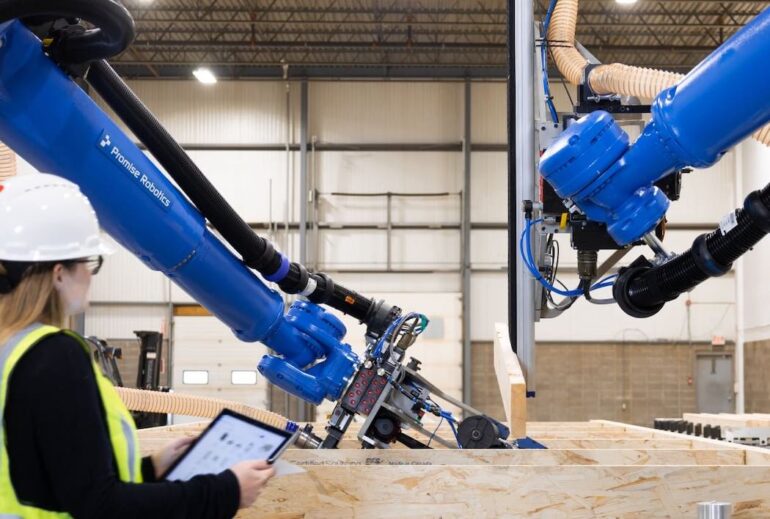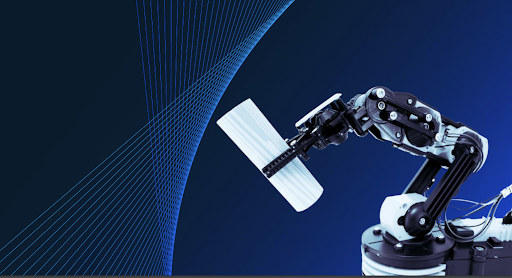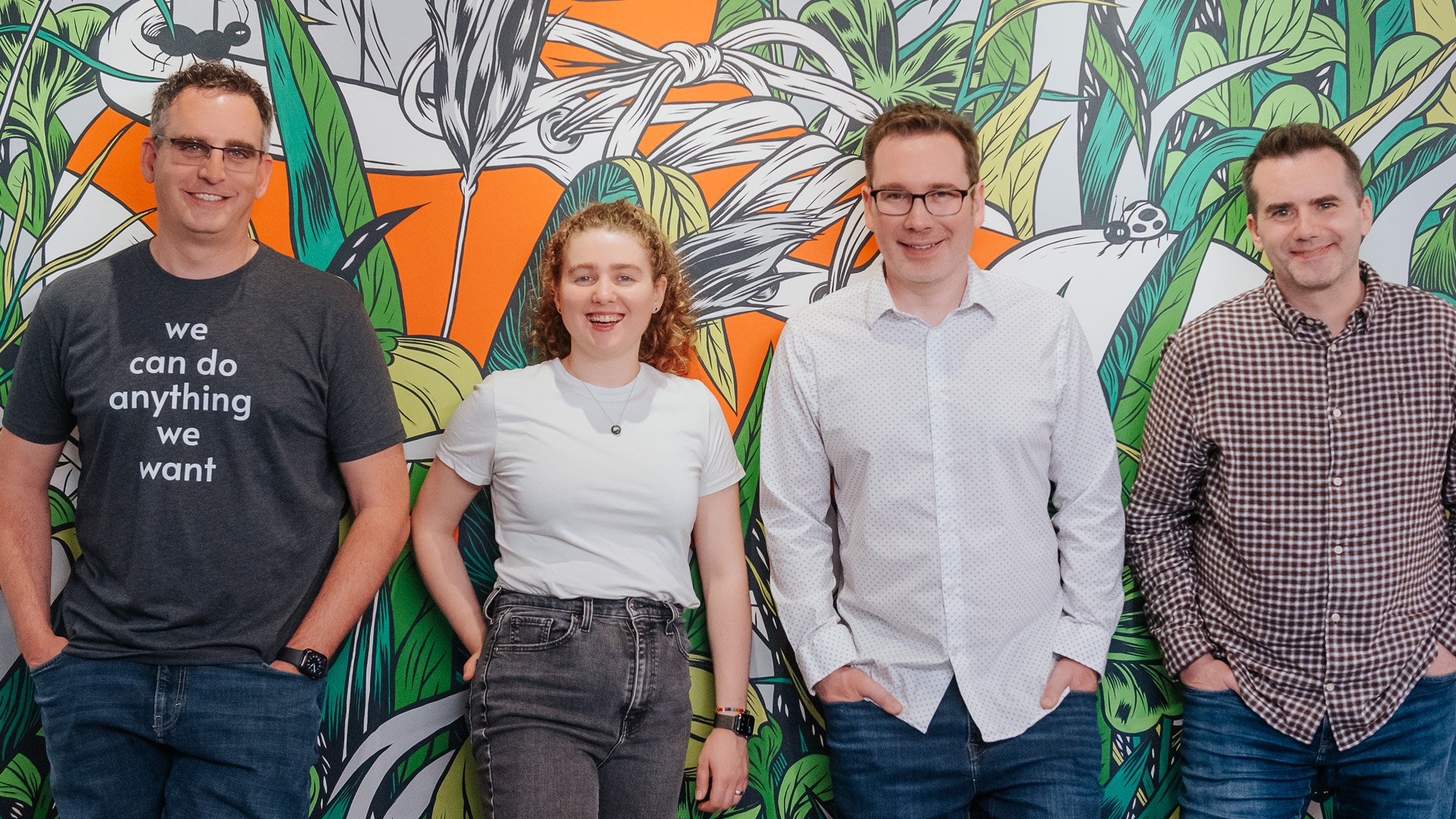Radical Venture’s Inflection Point series profiles prominent founders and researchers using AI to address the greatest challenges facing humanity today.
This week’s Inflection Point features Ramtin Attar. Ramtin is the Co-Founder and CEO of Radical Ventures portfolio company Promise Robotics, which is leveraging the efficiencies of industrialized automation to usher in a new era of affordable and sustainable home construction. From design to production and assembly, Promise Robotics develops advanced industrial robotic systems for the production of building components. As an industry pioneer and a founding member of Autodesk Research and former Head of Autodesk Technology Centre in Canada, Ramtin brings more than 16 years of leadership experience in helping the building industry to innovate and adopt new technologies for better productivity and sustainability. We asked Ramtin about his vision for the future of AI technology in his field.
1. What is the most important development in AI right now?
Ramtin Attar (RA): The impact AI could have on the physically built environment we inhabit every day. From the lack of affordable housing to the shortage of labour and the challenges of moving towards a Net-Zero economy, AI-enabled automation could help us to make significant progress in how we create our housing and other elements of our physical world.
At Promise Robotics, we are using AI to completely change the economics of automation, aiming to build more affordable and sustainable housing. Performing complicated tasks around the assembly of physical components at scale – and making the technology broadly available – is fundamentally a challenge best addressed by AI.
2. How is it changing your business outlook?
RA: Critical issues, such as the lack of supply of housing and greenhouse gas emissions, are not simply going away. COVID-19 exacerbated many existing issues that the construction industry has been facing for decades. In particular, the labour shortage is a systemic issue facing the industry. At the end of 2021, we saw a 158% increase in construction-related job vacancies. In both Canada and the United States, the labour shortage in the industry is over a million people.
The issue here is not just a matter of headcount. We are also seeing a major shift in new skills required to make the construction industry more aligned with the future. We are seeing the industry accelerate its adoption of automation technologies as the pressure mounts for the industry to transform.
3. If AI could solve one challenge, what should it be?
RA: Affordable and sustainable housing. Housing is at the centre of how we create healthy and prosperous communities. To build more housing, we need to lower the existing barriers and equip the construction sector with transformative tools to scale the construction of more sustainable housing. This will also have a major impact on reducing waste and greenhouse gas emissions produced by our building sector. AI will have a major impact in helping us to address this challenge.
AI News This Week
-
Infima appoints fintech and ESG veteran Hendrik Bartel as CEO, closes early-stage investment led by Radical Ventures (Accesswire)
Infima, a provider of advanced solutions for fixed-income markets, has emerged from stealth with a $5m seed round led by Radical Ventures, alongside Franklin Templeton and ThirdStream Partners. Initially focused on the $10+ trillion mortgage market, Infima harnesses data of unprecedented size and granularity to provide investors, dealers, lenders, and servicers with accurate and timely projections of future borrower, security, and market behaviour. Infima is a Stanford University spinout co-founded in 2020 by Kay Giesecke, a pioneer of large-scale deep learning systems in mortgage markets (Giesecke directs Stanford’s Advanced Financial Technologies Laboratory and leads its Mathematical and Computational Finance program). Infima also announced that it has appointed fintech veteran Hendrik Bartel as Chief Executive Officer.
-
ProtGPT2 is a deep unsupervised language model for protein design (Nature Communications)
A team at the University of Bayreuth has successfully applied a computer-based natural language processing model to protein research. According to the team, natural languages are structured very similarly to the way amino acids arrange themselves. The ProtGPT2 model designs new proteins that are capable of stable folding and could take over defined functions in larger molecular contexts. The model now understands the language of proteins and can use it creatively, potentially to solve previously unsolvable medical problems. The model can also create proteins that do not occur in nature and possibly never existed. The AlphaFold prediction of ProtGPT2-sequences reveals topologies not captured in current structure databases.
-
New insight into the development of the visual system in mice (MedicalXpress)
A new study in mice has revealed never-before-seen details about how the complicated visual network forms in them. This could help software engineers develop better and more general-purpose AIs. Researchers have shown that parallel neural pathways from the retinas in the eyes leading up to the cortical areas form earlier than previously thought. The team’s hypothesis is that their research can likely explain visual development in primates, including humans. This could help researchers aiming to treat congenital blindness.
-
AI is not sentient. Why do people say it is? (New York Times – subscription required)
Ben Goertzel has spent 25 years trying to create a machine that thinks like a human but found the most human-like moments to be an illusion created by the machine mimicking what he had written at a well-timed moment. Many people in the AI field, closest to the technology, “live with one foot in the future. They sometimes see what they believe will happen as much as they see what is happening now,” notes Cade Metz, New York Times reporter and author of Genius Makers which tells the modern history of AI. While AI can generate images, tweets, stories, and hold a simple conversation, there is no evidence that AI technology is sentient or conscious. “The computational capacities of current AI like the large language models don’t make it any more likely that they are sentient than rocks or other machines,” states Alison Gopnik, professor of psychology and a member of the AI research group at the University of California, Berkeley. Cade further explores the question with prominent AI researchers and entrepreneurs throughout the article.
-
Ambitious researchers want to use AI to talk to all animals (Futurism)
From smart pet doors with facial recognition to health monitors, researchers are commercializing machine learning applications in the $123 billion pet market. Most recently, a group of researchers are using machine learning to translate animal “languages” into something humans can understand. The Earth Species Project (ESP) was founded in 2017 with Silicon Valley investors like LinkedIn Co-Founder Reid Hoffman. ESP plans to first decode animal communication via machine learning and then make its findings available to all.
Radical Reads is edited by Leah Morris (Senior Director, Velocity Program, Radical Ventures).




